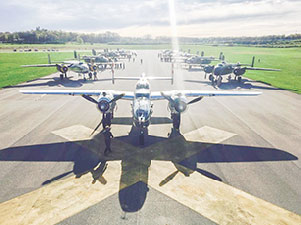It has been 75 years since the Doolittle Tokyo Raid on Saturday, April 18, 1942. Of the 80 men who participated Lt. Col. Richard “Dick” Cole who lives in Comfort, Texas is now 101 years old, but the day of the attack, he was a young man who took off from an aircraft carrier in one of sixteen bombers that would change history forever as the raid forced the Japanese military to divert resources during WW II. This was the first air strike that served as retaliation for the Japanese attack on Pearl Harbor just four months earlier. Cole was the co-pilot who sat next to Jimmy Doolittle, the leader of the mission.
On Friday, April 14, 2017 local aircraft enthusiasts made the jornery to the Champaign Aviation Museum in Urbana, OH to not only view the restored B-25J “Champaign Gal” which is on display at the museum, but to also witness the arrival of about two dozen of the original approximately 10,000 aircraft built by North American Aviation. The planes and their crews flew in every theater of World War II and were also used by many air forces after the war for four decades.
This gathering of the airworthy B-25s was billed as the “largest gathering of B-25s since WWII. From Friday through Easter Sunday, the public could get up close to the aircraft on static display. Six of the aircraft held rides for anyone willing to pay for the privilege of going up in the antique planes.
The “Ghost Squadron” which is a part of the Commemorative Air Force from the Missouri Wing flew the “Show Me” to Grimes Field on Friday, April 14. CAF Col. Bob Moore shared the experience of the crew when they stopped at Fairfax, KS for a stopover on their way to Urbana. Nineteen women who worked for North American Aircraft for just 75 cents per hour were on hand at the airport to greet the crew and look over the plane that they had built. Because this was a top secret project, only women worked in the plant. None of them had ever seen a finished aircraft leave the assembly building because of the nature of the project and yet each of them could point to the exact rivets or other parts of the plane that they helped to build. The women worked 8 hour shifts 7 days per week as the plant turned out aircraft 24 hours per day. They recounted how they were driven back and forth from a hotel that served as a sort of dormitory for the workers. They ate at the plant and pretty much were kept busy enough that they could not make it to one of the local shops to talk about the work they were doing in top secret conditions back then. They also explained that they came up with songs to make the tedious work go faster with lyrics such as “we can do it, yes we can”. The photos that are seen on posters even today with “Rosie the Riveter” came from the fact that the women had to wear hairnets to keep anything from falling into the delicate parts during assembly. The women took to wearing the red bandana as it was more comfortable and Rosie was born. Men were kept out of the plants because they would often follow up a long work day by a visit to the pub according to the women. The government and the company could not take a chance of loose lips sinking the secret work being done.
The planes were launched on that day in April from the USS Hornet about 300 miles further away than planned and earlier than was planned due to the sight of enemy ships. The bombers had 646 gallons of fuel in the Wing Tanks and 225 gallons in the half Bombay Tank. They also carried 160 gallons in the Crawlway Over Bomb Bay, 10-5 in cans and 60 gallons in the Lower Turret for a total of 1,141 gallons.
After dropping their bombs, the crews ran short of fuel at night rather than in the daylight hours and were unable to return as planned. One plane landed in Siberia however the other fifteen were ditched. Of the crew members, 5 were captured, 3 were executed, 1 died in prison and 4 were held prisoner until the end of the war. Sixty two men returned from China to continue their service for the remainder of the war.
The B-25 was used even after the end of World War II because it had the ability to fly low over the trees and use the mounted and movable guns easily. On the “Show Me’’ it was intriguing that the rear guns were surrounded by a heavy canvas making it easy to maneuver the guns. The side guns also had a similar covering. Guns were located at the front, rear, sides and top of the plane. Moore explained that the gunner in the top of the plane was also responsible to drop the bombs on the target.
Visitors over the weekend not only were able to view the largest collection of operating aircraft, but to also hear the many stories of those who restored and fly the aircraft today.
The Gathering moved on to The National Museum of the US Air Force on Monday morning where the display continued until 4 pm. On Tuesday the planes departed with a flyover to start the memorial service which was to conclude with a flight of two B-1 bombers from the 34th and 37th Bob Squadrons located at Ellsworth Air Force Base in South Dakota. The aircrews of the Doolittle Raid were selected from these Army Air Corps Squadrons along with two others. Lt Col. Cole planned to be at the museum to privately honor fellow Raider SSgt David Thatcher who passed away in 2016.


